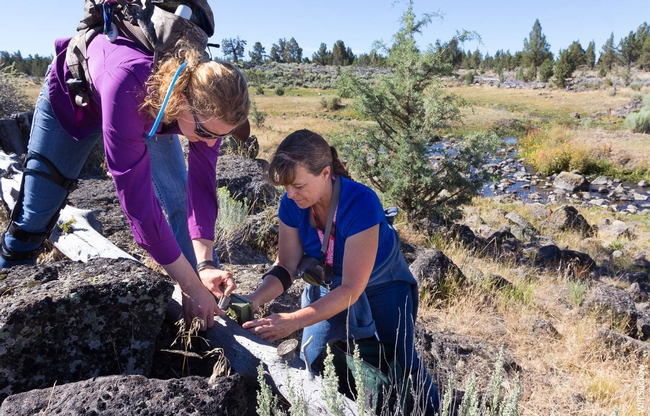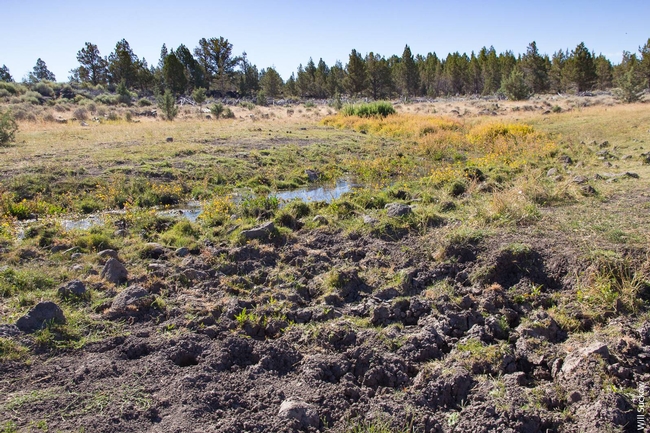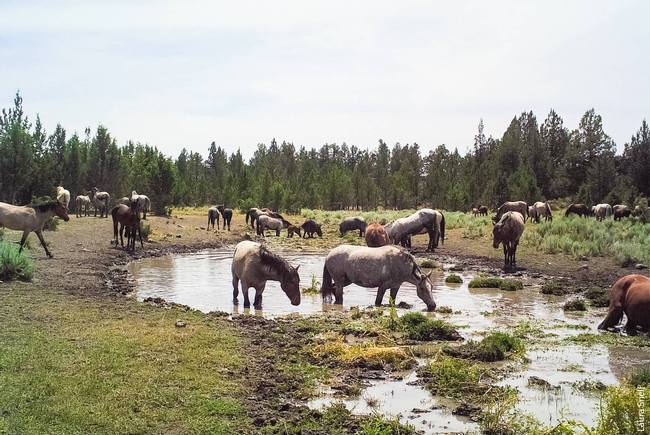
Posts Tagged: horses
Wild horse over-population is causing environmental damage
Most Americans envision healthy mustangs galloping free on the range when they think about the country's wild horse population. But UC Cooperative Extension rangeland advisor Laura Snell sees another image.
In conducting research on the over-populated wild horse territory at Devil's Garden Plateau in Modoc County, she witnesses a group of horses visiting a dwindling and damaged pond.
“Maybe there is enough for the lead stallion and the lead mare to drink. The rest stand there and look longingly at the diminished water source,” Snell said. “They do not seem content.”
The research Snell has underway at Devil's Garden was chronicled in the current issue of California Agriculture journal by executive editor Jim Downing. The federal government has determined the ideal horse population on the 230,000 acres of wild horse territory is no more than 402, however, more than 2,000 wild horses are running on the land.
Snell began working in the remote northeast corner of California in 2015.
“I had Modoc County ranchers coming up to me on my second day of work asking me how to solve the wild horse issue,” she said.
She realized that agencies and authorities responsible for policies that determine the horses' fate, and advocates who lobby strongly that the horses should be cared for humanely, don't see the poor conditions suffered by the horses and the environmental degradation of the land.
“The area is a quarter million acres in size. There are no main roads, so you have to take ATVs to see the horses,” Snell said. “We realized we needed to provide visuals to show people the horses and what the landscape looks like due to unmanaged grazing by the wild horses.”
Snell places wildlife cameras for two-week periods near 24 remote water sources in wild horse territory in Modoc and Lassen counties. At each site, the camera takes a burst of three pictures automatically every 15 minutes; motion detectors on the cameras also trigger a shot whenever an animal enters the field of view.
Preliminary data from 2015 show some striking findings. At one spring site, for instance, more than 71 percent of all animals detected over the sampling period were horses. Cattle accounted for 19 percent and the rest were pronghorn antelope, deer and hawks. The study will continue through 2017.
Wild horses are running in the Devil's Garden territory, and outside the territory, on private and tribal land. Fences don't hold the horses in, Snell said. Federal wild horse management areas are intended for multiple uses, including livestock grazing, hunting, and wildlife habitat. But in Devil's Garden, livestock have been excluded because of the environmental degradation.
“It was never intended to be single use area,” Snell said. “The horses are gorgeous animals, but I also like to see pronghorn, elk and mule deer. Some groups of wild horses are getting large and studs are getting aggressive. I know people who no longer ride their personal horses because it's not really safe with the territorial nature of the stallions.”
The images and data from Snell's research are designed to inform management and policy decisions in hopes of easing the expensive and environmentally harmful wild horse over-population. Already U.S. Representative Doug LaMalfa (R-Oroville) has brought the study to the House Committee on Natural Resources and preliminary results have been shared with Bureau of Land Management's Wild Horse and Burro Advisory Board.
What's in your compost?

Michele Jay-Russell, a veterinarian and research microbiologist at the Western Institute for Food Safety and Security (WIFSS) and program manager of the Western Center for Food Safety (WCFS), recently co-authored a study that highlights the need to be aware of the hazards associated with using raw animal manure to fertilize home gardens. (Read full article here.)
The basis for the study began in July of 2010 when a shire mare from a rural Northern California farm was brought to the William R. Pritchard Veterinary Medical Teaching Hospital for treatment of colic. Following protocol, the veterinarians on call screened the horse for Salmonella to avoid infecting other horses during hospitalization. She tested positive and after successful treatment for colic, went home. Her owners then notified the veterinarians that some of their other draft horses were sick as well — all 8 were tested and 6 came back positive for the same Salmonella Oranienburg strain, including the mare that still had the infection.
Jay-Russell heard about the case from her colleague John Madigan, professor of medicine and epidemiology at the school. The farm’s owners invited Jay-Russell and Madigan to the farm to see if they could uncover the source of the Salmonella infection. They sampled water from horse troughs, manure storage piles, wild turkey feces and soil from the family’s edible home garden where raw horse manure had been used as fertilizer. Each of those locations had a percentage of positive samples over the sampling period from August 2010 to March 2011.
“We showed the owners how to continue collecting samples and provided them with a FedEx number to ship them to UC Davis,” Jay-Russell said. “During that whole time, the garden soil kept coming back positive, which showed that this strain of Salmonella could persist for months.”
While the researchers couldn’t be completely certain about the original source of Salmonella on the farm, they suspect that a recent surge in the wild turkey population on the property introduced the bacteria to the horses by pooping in the horse corrals and in the water troughs. They speculated that the wild turkeys brought the Salmonella onto the property, although they couldn’t rule out the possibility that the birds were exposed on the farm or to other potential sources of Salmonella.
“What is clearer is that the raw horse manure applied as fertilizer was the most likely source of garden soil contamination,” Jay-Russell explained. “We suspect that the damp climate in Mendocino County may have contributed to the longevity of this bacterium in the soil long after the owners stopped applying the horse manure to the garden. Fortunately, the owners didn’t get sick, but our investigation showed the potential for widespread dissemination of Salmonella in a farm environment following equine infection.”
To promote safe gardening practices, Jay-Russell has teamed with Trevor Suslow, a Cooperative Extension food safety specialist in the Department of Plant Sciences, to speak to groups of small farmers around the state about best practices. They also use a brochure in English and Spanish, “Food Safety Tips for Your Edible Home Garden,” that includes information about safe uses of animal manure and ways to minimize animal fecal contamination.
“It’s good to let people know about the risks and to correct misinformation about ways to treat the compost pile before using it in the garden,” Jay-Russell said. “The biggest take home message from this experience is to be very careful about using manure from sick horses — and to be cautious about offers of free manure — you don’t know what’s in there. Commercial compost should be bought from a reputable source.”
She urges gardeners to take a class and learn how to compost correctly and safely. Each county in California has UC Cooperative Extension advisors and many have Master Gardener programs offering information on food safety.
Additional resources:




